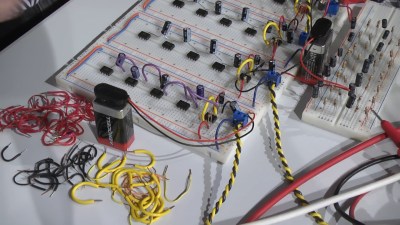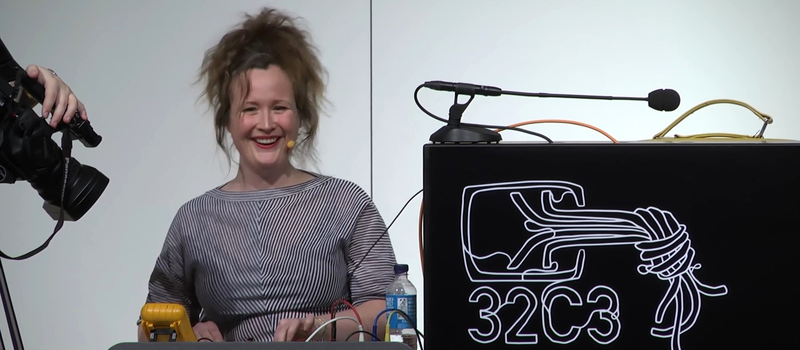In terms of implausible stand-up comedy, [Darsha]’s “20 Oscillators in 20 Minutes” is pretty far out there. First of all, she’s sitting down, with googly eyes on her multimeter, and five breadboards and a mess of 9V batteries laid out in front of her. “Has anybody built electronics before? Has anybody built electronics in front of this many people before? Yeah, so you’d better f**king be nice.” And she’s off!
 “Square waves are really good for your speakers.” And a few seconds later, a lub-dub beat-frequency oscillator filled the hall. And then there’s the stand-up clichés: “Anyone in the audience from Norway?!” And “Anyone know what chip I’m using here?” (The 555.) A heckler, or participant, shouts up “What are you doing?” She responds “Building this!” and shows a sketch of the basic layout.
“Square waves are really good for your speakers.” And a few seconds later, a lub-dub beat-frequency oscillator filled the hall. And then there’s the stand-up clichés: “Anyone in the audience from Norway?!” And “Anyone know what chip I’m using here?” (The 555.) A heckler, or participant, shouts up “What are you doing?” She responds “Building this!” and shows a sketch of the basic layout.
She baits the audience — “Do you want to ask me about duty cycles?” — and tells stories: “And then one time the solder fell in my lap and burned through my crappy jeggings. Who knows what jeggings are? Whooo!!” All the while the clicking gets louder and more complicated.
Then there’s the suspense. “11 minutes left? Shit, I dunno if I’m going to make it this time!” She’s visibly panicked. A question: “How do you protect the outputs from overvoltage?” “I don’t. (pause, laughter) I use some filter caps and just, well, hope that you guys have good insurance.”
Nearing the home stretch, there’s this quasi-rhythmic ticking and pulsing slowly building up in the background. She plugs in another capacitor, and the crowd spontaneously applauds. A little bit later, she shouts “Is it loud enough?” over the din and turns it down. At the end, the timing’s getting really tight, and she calls up someone to help from the audience.
We won’t spoil it, naturally. You’ll just have to watch it run to the end. We laughed, we cried. It was better than Schroedinger’s cats.
(We’d use hex inverters.)
















From the title of this talk I was expecting to see 20 different Oscillators circuits, not one circuit with multiple R’s and C’s. Maybe one circuit using a Gunn Diode for 140GHz and another one using ……
That’s what I was hoping for, too…
If the 555 Timer Oscillator is not exciting enough for you, then why don’t you check out this project instead: http://www.sideman5000.org I talk about much fancier electronics in those videos.
site does not work did you typo or are you a member of a private site
if you can still get to the site download the video and post to youtube
I’m sure I may be missing something… but I don’t really get it. It’s just a person building noise. That’s it. Could have been nice to couple outputs to the next oscilator and cause some sort of rythm.
Even her personality… it’s like the female version of that dude with klein bottles that jumps around a TED stage.
#justatrollpassingby
Dear Juan: I was invited to do a performance artwork – this performance artwork in particular does not involve a scope (nor does it involve…rhythm – sorry!). But, if you like seeing wave shapes on scopes then I would suggest checking out my other project here: http://www.sideman5000.org esp. episode 8 about sound synthesis.
Vulgar self congratulation. What on earth was so good about that?
dear bored: Thanks for your feedback – For more Vulgar self congratulation, check out this project: http://www.sideman5000.org
I expected 20 different circuits and maybe a quick, this is why it’s good. Would make an excellent talk.
Not someone showing that they have mastered their first electronics set and can manage to put jumpers and components into half completed breadboards.
To be fair it was a CCC talk and they do have a history of catering for performance artists who use technology, some of which can be more interesting than others for the technically inclined.
Dear Martin – might have been good to read the description of the talk to avoid being disappointed. I think that a talk about 20 different oscillators would be an awesome too! Are my boards really half completed? If you want something more complicated, maybe check out the project I published about restoring the world’s oldest drum machine http://www.sideman5000.org
I am wondering how random this noise is?
If you could measure/characterise all of the components used, calculate the temperature changes within the circuit from currents and the ambient changes in the room you could in theory predict the output drift. But with a large number of people in the room generating various amounts of heat, it should add enough microscopic thermal fluctuations to get good entropy out from the circuit.
Clock drift is used to generate random numbers https://en.wikipedia.org/wiki/Hardware_random_number_generator#Clock_drift
And watchdog timer’s natural jitter in embedded electronics has been used as well – https://hackaday.com/2014/05/24/the-most-random-electronic-dice-yet/
But oscillators running at nearly the same frequencies and using the same power bus tend to get synchronised to eachother after a while. That would be bad for the randomness…
If you only need a few bits of entropy every couple of seconds, sometime it is good enough.
Besides oscillators locking as [matseng] mentions, they’re all running at roughly the same speed.
Each osc has only one bit (on/off) of information. So lets say that’s a twenty-bit random number. If you looked again in a millisecond, you’d very likely have exactly the same number again, or maybe one or two bits off.
And if you looked at it for a while, you’d be able to predict the future state minutes out into the future — don’t use it for crypto.
You’d do better flipping coins.
*yawn*
If you want more yawns then check out this other project I did. http://www.sideman5000.org
@Elliot Williams – thanks for the writeup! I’m curious – why would you use hex inverters? Is it because they offer more of a tonal range? I like them too but they are not really suited for this project. On one hand, it is too easy to make them sound really cool and impressive (I’m not really going for music here) – I like the simplicity of the 555 output. Other than that, I have tried to speed build hex inverter oscillators – often there are several crammed onto one chip which makes it damn annoying to build up fast and well, less visually impressive ;) BTW – my Pal Peter Edwards does a very nice tutorial here based on the 40106: https://www.youtube.com/watch?v=FaoJaLmZaL4
@Darsha: Partly parts count, partly b/c they’ve got more magic glitches inside. Having the six oscs on the same chip makes them lock and cross-modulate and all sorts of wacky stuff, esp. if the voltage supply is insufficient. But also I wanted a hook to link in my series of articles here, and it was all I could think of. Lame, I know.
Hadn’t thought about the visual impact end of things at all, though. Lower parts count is probably not something you’re going for. At the rates you’re firing, LEDs? (Yay, more stuff to go wrong in a live demo!)
Peter’s stuff is fun — I used to crib his circuits from Caspar Electronics (a decade?!?) ago.
And an apology for a bunch of the comments here. Dunno what’s up with the haters. When you’re doing electro-nerdy-standup-parody-sound-whatever-the-heck-that-was, I’m not too shocked that some folks can’t really figure out what’s going on. I thought I warned them…
Great idea for a performance – given me lots to think about! Cheers :) G
“Maker” level stooopid… But heck, it IS “Women & STEM” after-all.
dude – you’re stooopid and likely, a sad virgin, so – I won’t take this comment personally.
I didn’t watch the whole thing for learns but for funs. I love this woman. Fuck the haters.
I was expecting a higher frequency than about 1Hz . X twenty sources.